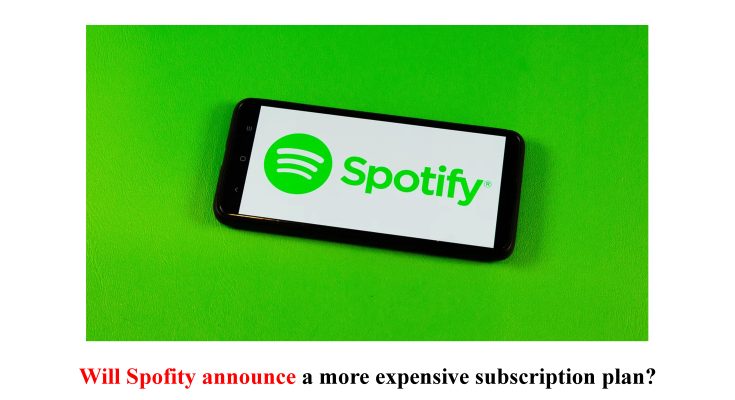Introduction to Spotify and its current subscription plans
Spotify has become a household name in the world of music streaming. With millions of active users, it offers various subscription plans tailored to diverse needs. From the free tier loaded with ads to premium subscriptions that promise an ad-free experience and offline listening, there’s something for everyone.
But as we dive deeper into 2023, whispers are circulating about a potential shake-up in Spotify’s pricing structure. Could we be on the brink of a more expensive subscription plan? As artists continue to navigate their careers post-pandemic, how will this affect both them and listeners? Let’s explore these questions and see what might lie ahead for Spotify subscribers.
Speculations about a possible price increase
Rumors about a possible price increase for Spotify have been circulating recently. Many users are curious if the popular streaming service will adjust its subscription fees.
Industry insiders suggest that rising operational costs might play a role in this decision. With the music industry evolving, maintaining quality and licensing agreements can be expensive.
Some analysts believe Spotify could introduce tiered pricing options to cater to different user needs. This strategy might allow them to offer additional features while justifying higher prices.
Social media chatter reflects mixed feelings among users. While some appreciate potential enhancements, others worry about losing access due to increased costs.
The uncertainty surrounding these speculations keeps subscribers on edge, eager for any official announcement from Spotify about changes in their plans or services.
The impact of the pandemic on music streaming services
The pandemic changed how we consume music. With concerts canceled and live events on hold, many turned to streaming services for entertainment.
Spotify, like other platforms, saw a surge in users during lockdowns. People craved connection through music when social interactions faded. Daily listening habits shifted as playlists became the soundtrack of isolation.
Artists adapted too. Many released new tracks directly to streaming platforms rather than waiting for traditional album tours. This strategy kept fans engaged and allowed creators to maintain visibility.
However, the increase in listeners brought challenges as well. Streaming royalties remained a contentious topic among artists trying to earn fair compensation from their work.
Despite these hurdles, it’s clear that the pandemic accelerated the shift towards digital consumption of music—forever altering how fans connect with their favorite artists and genres.
Comparison with other streaming platforms’ pricing strategies
When examining Spotify’s pricing strategies, it’s essential to look at its competitors. Apple Music offers a similar subscription model but often includes exclusive releases and curated playlists that attract users willing to pay for unique content.
Amazon Music Unlimited provides an interesting twist by bundling services with Prime memberships. This approach not only boosts sign-ups for Amazon Prime but also makes music streaming more accessible to millions of users who already subscribe.
YouTube Music operates on a freemium model, allowing listeners to access ad-supported content without paying upfront. This attracts a diverse audience but can limit the revenue generated from dedicated subscribers.
Tidal stands out with its high-fidelity audio quality and artist-centric payment model, appealing mainly to audiophiles and those looking for premium experiences. Each platform has carved out its niche while navigating the competitive landscape of music streaming prices.
Potential benefits for Spotify and its users
A potential price increase for Spotify could open up new avenues for enhancements. With additional revenue, the platform might invest in exclusive content and artist collaborations. This could mean unique releases that you can’t find anywhere else.
Users may also benefit from improved features. Think better algorithms for personalized playlists or enhanced audio quality options. A higher subscription tier could cater to audiophiles seeking a richer listening experience.
Moreover, increased funds might boost customer support services. Faster response times and more resources could elevate user satisfaction significantly.
For artists, a premium pricing strategy can lead to fairer compensation models. More money flowing into the platform means opportunities for better royalty structures. This would create a win-win situation where both users and creators feel valued within the ecosystem of music streaming.
Potential drawbacks and concerns for users
Increased subscription fees could deter some users. Many rely on Spotify for affordable music access. A price hike might push them toward free, ad-supported alternatives.
There are also concerns about value perception. If new features don’t justify the higher cost, subscribers may feel shortchanged. Loyalty can wane quickly when consumers perceive they aren’t getting their money’s worth.
Another worry is accessibility for casual listeners or students who already struggle with tight budgets. Losing these segments could shrink Spotify’s user base significantly.
Additionally, a more expensive plan risks alienating existing customers who have been loyal for years. They may question whether it’s time to explore other platforms instead of sticking with the familiar service they love.
User frustration is valid in this scenario, especially if competition remains fierce and offers better deals elsewhere.
Conclusion
Spotify has become a household name in the music streaming industry. Its extensive library, user-friendly interface, and variety of subscription plans make it a go-to choice for millions around the world. Currently, Spotify offers several options, including a free tier supported by ads and premium subscriptions that cater to different needs.
Recently, there has been growing speculation about whether Spotify will announce a more expensive subscription plan. Such discussions often arise when users notice new features or services being rolled out, leading them to wonder if these enhancements might come with an increased price tag.
The pandemic had profound impacts on various industries, and music streaming was no exception. With people confined to their homes during lockdowns, platforms like Spotify saw surges in user engagement as individuals sought entertainment and solace through music. However, as life returns to normalcy post-pandemic, many are questioning how this shift may affect pricing strategies moving forward.
When comparing Spotify’s current pricing with other platforms such as Apple Music or Amazon Music Unlimited—both of which offer similar features at competitive rates—it’s clear that any potential hike could influence subscriber loyalty. Many users are loyal due to affordable prices; thus any increase could lead some subscribers to reconsider their options.
On one hand, raising subscription fees can provide enhanced resources for artists and better content for listeners while also allowing Spotify to invest further into innovative features. These improvements could mean higher sound quality streams or exclusive artist partnerships that benefit both creators and fans alike.
However, potential drawbacks exist too. A price increase might alienate budget-conscious consumers who rely on affordable access to music in today’s economic climate where finances remain tight for many households. Users have grown accustomed to certain pricing structures; changes may not be well-received by all segments of the audience.
As anticipation builds regarding what moves Spotify will make next concerning its subscription models—including whether they will announce alterations in pricing—the outcome remains uncertain yet intriguing for both users and stakeholders alike.


